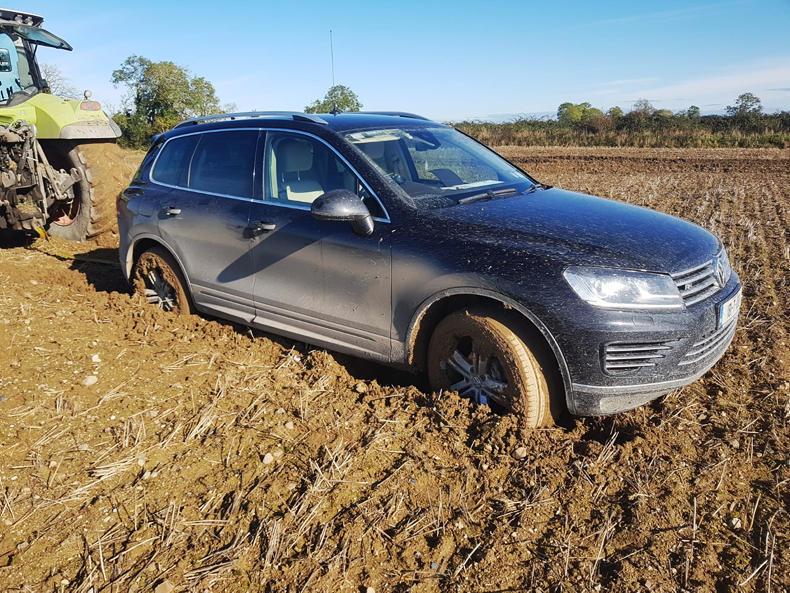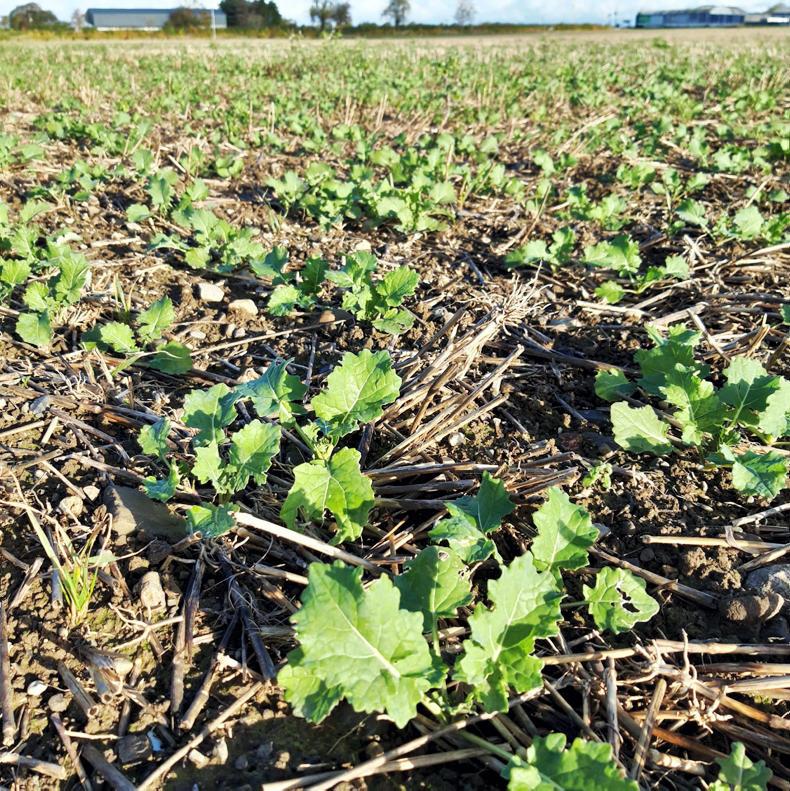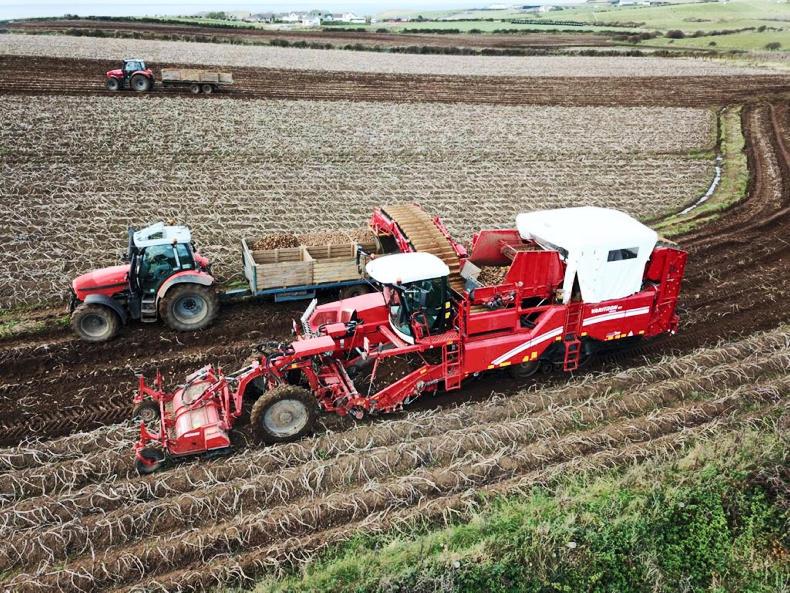
Ballyragget,
Co Kilkenny
James has around 90% of his planned winter barley and wheat area sown. This has been far from straight-forward, he explains. Like many other locations, the weather in Kilkenny this autumn has been very broken and ground conditions have been poor.
James began sowing his first winter wheat crops after oilseed rape at the start of October. He generally didn’t get two good days’ sowing in a row and was rained off for up to seven days at a time. Ground has been a challenge he admits and he has had to leave patches of fallow in areas too wet to sow. His tractor and drill have also bogged several times this sowing season.

Conditions have been hard on man and machine this autumn. After towing his jeep to drier ground, James decided to leave this patch of a field in fallow for the season.
James explains that the unsown areas will likely be left in fallow next spring. As James farms areas in blocks, it doesn’t make sense to sow a small area with a different crop and knock the block out of sync. He may take the opportunity to complete some drainage work to those fallow areas next year.
He has finished sowing all of his land designated for winter oats on this week. He sowed the variety Husky at 170kg/ha. However, due to the poor weather, James will inevitably have an amount of spring crops next year.
James explains he will aim to minimise the disruption to his rotation in the following years as a result of this unplanned area of spring crops.
He did make the point that for those who will have a higher amount of spring crops in 2020, this may be a good opportunity to grow a break crop, especially in the absence of a spring malting barley or seed contracts.
James sowed his Graham, Costello and JD Diego winter wheat crops at between 140kg/ha and 175kg/ha depending on ground conditions and planting date. He capped the seeding rate of his Belfry hybrid barley at 117kg/ha in order to prevent an overly thick crop developing.
He hasn’t applied any slug pellets this year but is keeping a very close watch on populations.
He missed the window for pre and peri-emergence herbicide applications on his winter crops but will aim to spray them at the three-leaved stage.

Athy, Co Kildare
When it comes to direct drilling crops, having patience with the weather is essential. This was especially true this autumn, explains Andrew, who started and finished sowing last week.
“With direct drilling, you may have to be more patient with the weather, but you cover a lot of ground once conditions are right,” he says.
Up until last week, weather conditions in Athy had been poor. Frequent rain showers prevented field work and appear to have slowed development of his winter oilseed rape crop.
In a perfect year, Andrew prefers to be drilling winter cereals directly into a summer cover crop. Typically, the summer cover is drilled directly after the harvest before desiccation seven to 10 weeks later. This year, however, Andrew only drilled around one-third of his winter cereals into a cover (tillage radish, buckwheat, white mustard and phacelia). The rest was drilled into disced stubble ground.

Andrews’s winter oilseed rape crop has been slow to develop and hasn’t been helped by weeks of wet weather following planting.
His winter cover crops in ground destined for spring cereals are still developing well despite the weather. He decided to apply a graminicide (Flacon at 0.6l/ha) on winter covers sown in fields which are between two crops of spring barley in the rotation. Andrew explains that he wanted to kill the spring barley volunteers to see if this would have a notable impact on net blotch levels in the following crop.
All of Andrew’s sowing took place over two days last week. He first sowed Graham winter wheat into pea stubble. The stubble was first disced to help break up the pea haulm before sowing with his Horsch Simba tined drill. The crop was sown at 185kg/ha with a seed TGW of 53g. Andrew is targeting 270 plants/m2. The crop is destined for the feed market.
He then moved on to sowing basic winter oat seed which had a TGW of 33g. The Husky crop is destined for seed and was sown at a rate of 135 kg/ha, aiming to establish 300 plants/m2.
Andrew applied chicken manure pellets at a rate of 300kg/ha before drilling on most of this ground.
He is keeping a close eye on slug populations and had to apply Axelea (4kg/ha) on one field of winter wheat following peas.

Bushmills,
Co Antrim
Antrim has enjoyed better weather over the past four weeks in comparison to Kilkenny and Kildare. Rainfall on Mark’s farm totalled around 55.6mm for that period, allowing him to make good progress with his potato harvest.
Ground conditions have dictated the pace of this year’s potato harvest. Mark explains that progress was very slow when harvesting potatoes in heavier ground in early October. This is despite the increased output from his new self-propelled Grimme 220 potato harvester. He explains that the harvester has been much easier on soil due to its flotation tyres and tracks.
In very wet areas of the field, Mark fills the 2t bunker on the harvester before unloading on to trailers in the dryer areas of the field. With his old trailed harvester, both harvester and trailers would have to travel through the wet area, causing a lot of damage to the ground.
He has now moved on to lighter ground and expects to be finished harvesting by the end of the week. Yields have been reasonable this year, as has skin quality.

Mark has been able to travel with ease on difficult ground thanks to the tracks in his new self-propelled potato harvester.
Mark is happy with how the crops are yielding, averaging around 15 t/ac from his Kerr’s Pink crops, 17-20t/ac from his Navan crops and 15-20t/ac in his Maris Piper crops (gross yields). The tubers are around 10°C to 12°C at the time of harvest. The crops are then loaded into ambient stores to cure, where temperatures are lowered to 7°C to 8°C. Once the harvest is complete, Mark will grade all of this crop before storing them at 3.5°C in his cold store for winter.
Mark sowed California winter barley in an amount of earlier harvester potato ground while the remainder was sown into stubble ground. The crops were sown at 188kg/ha and have all now emerged. Mark hasn’t had an opportunity to apply an autumn herbicide yet as he doesn’t want to leave ruts in the tramlines. However, if conditions continue to improve this week, he will aim to apply a flufenacet- and pendimethalin-based herbicide by the weekend.
Read more
Listen: wetter winters, dryer summers and invasive species - climate change
Grain prices: firmer market tone sees grain prices rise

Ballyragget,
Co Kilkenny
James has around 90% of his planned winter barley and wheat area sown. This has been far from straight-forward, he explains. Like many other locations, the weather in Kilkenny this autumn has been very broken and ground conditions have been poor.
James began sowing his first winter wheat crops after oilseed rape at the start of October. He generally didn’t get two good days’ sowing in a row and was rained off for up to seven days at a time. Ground has been a challenge he admits and he has had to leave patches of fallow in areas too wet to sow. His tractor and drill have also bogged several times this sowing season.

Conditions have been hard on man and machine this autumn. After towing his jeep to drier ground, James decided to leave this patch of a field in fallow for the season.
James explains that the unsown areas will likely be left in fallow next spring. As James farms areas in blocks, it doesn’t make sense to sow a small area with a different crop and knock the block out of sync. He may take the opportunity to complete some drainage work to those fallow areas next year.
He has finished sowing all of his land designated for winter oats on this week. He sowed the variety Husky at 170kg/ha. However, due to the poor weather, James will inevitably have an amount of spring crops next year.
James explains he will aim to minimise the disruption to his rotation in the following years as a result of this unplanned area of spring crops.
He did make the point that for those who will have a higher amount of spring crops in 2020, this may be a good opportunity to grow a break crop, especially in the absence of a spring malting barley or seed contracts.
James sowed his Graham, Costello and JD Diego winter wheat crops at between 140kg/ha and 175kg/ha depending on ground conditions and planting date. He capped the seeding rate of his Belfry hybrid barley at 117kg/ha in order to prevent an overly thick crop developing.
He hasn’t applied any slug pellets this year but is keeping a very close watch on populations.
He missed the window for pre and peri-emergence herbicide applications on his winter crops but will aim to spray them at the three-leaved stage.

Athy, Co Kildare
When it comes to direct drilling crops, having patience with the weather is essential. This was especially true this autumn, explains Andrew, who started and finished sowing last week.
“With direct drilling, you may have to be more patient with the weather, but you cover a lot of ground once conditions are right,” he says.
Up until last week, weather conditions in Athy had been poor. Frequent rain showers prevented field work and appear to have slowed development of his winter oilseed rape crop.
In a perfect year, Andrew prefers to be drilling winter cereals directly into a summer cover crop. Typically, the summer cover is drilled directly after the harvest before desiccation seven to 10 weeks later. This year, however, Andrew only drilled around one-third of his winter cereals into a cover (tillage radish, buckwheat, white mustard and phacelia). The rest was drilled into disced stubble ground.

Andrews’s winter oilseed rape crop has been slow to develop and hasn’t been helped by weeks of wet weather following planting.
His winter cover crops in ground destined for spring cereals are still developing well despite the weather. He decided to apply a graminicide (Flacon at 0.6l/ha) on winter covers sown in fields which are between two crops of spring barley in the rotation. Andrew explains that he wanted to kill the spring barley volunteers to see if this would have a notable impact on net blotch levels in the following crop.
All of Andrew’s sowing took place over two days last week. He first sowed Graham winter wheat into pea stubble. The stubble was first disced to help break up the pea haulm before sowing with his Horsch Simba tined drill. The crop was sown at 185kg/ha with a seed TGW of 53g. Andrew is targeting 270 plants/m2. The crop is destined for the feed market.
He then moved on to sowing basic winter oat seed which had a TGW of 33g. The Husky crop is destined for seed and was sown at a rate of 135 kg/ha, aiming to establish 300 plants/m2.
Andrew applied chicken manure pellets at a rate of 300kg/ha before drilling on most of this ground.
He is keeping a close eye on slug populations and had to apply Axelea (4kg/ha) on one field of winter wheat following peas.

Bushmills,
Co Antrim
Antrim has enjoyed better weather over the past four weeks in comparison to Kilkenny and Kildare. Rainfall on Mark’s farm totalled around 55.6mm for that period, allowing him to make good progress with his potato harvest.
Ground conditions have dictated the pace of this year’s potato harvest. Mark explains that progress was very slow when harvesting potatoes in heavier ground in early October. This is despite the increased output from his new self-propelled Grimme 220 potato harvester. He explains that the harvester has been much easier on soil due to its flotation tyres and tracks.
In very wet areas of the field, Mark fills the 2t bunker on the harvester before unloading on to trailers in the dryer areas of the field. With his old trailed harvester, both harvester and trailers would have to travel through the wet area, causing a lot of damage to the ground.
He has now moved on to lighter ground and expects to be finished harvesting by the end of the week. Yields have been reasonable this year, as has skin quality.

Mark has been able to travel with ease on difficult ground thanks to the tracks in his new self-propelled potato harvester.
Mark is happy with how the crops are yielding, averaging around 15 t/ac from his Kerr’s Pink crops, 17-20t/ac from his Navan crops and 15-20t/ac in his Maris Piper crops (gross yields). The tubers are around 10°C to 12°C at the time of harvest. The crops are then loaded into ambient stores to cure, where temperatures are lowered to 7°C to 8°C. Once the harvest is complete, Mark will grade all of this crop before storing them at 3.5°C in his cold store for winter.
Mark sowed California winter barley in an amount of earlier harvester potato ground while the remainder was sown into stubble ground. The crops were sown at 188kg/ha and have all now emerged. Mark hasn’t had an opportunity to apply an autumn herbicide yet as he doesn’t want to leave ruts in the tramlines. However, if conditions continue to improve this week, he will aim to apply a flufenacet- and pendimethalin-based herbicide by the weekend.
Read more
Listen: wetter winters, dryer summers and invasive species - climate change
Grain prices: firmer market tone sees grain prices rise












 This is a subscriber-only article
This is a subscriber-only article










SHARING OPTIONS: